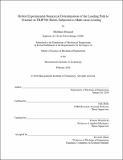| dc.contributor.advisor | Dirk Mohr and Tomasz Wierzbicki. | en_US |
| dc.contributor.author | Dunand, Matthieu | en_US |
| dc.contributor.other | Massachusetts Institute of Technology. Dept. of Mechanical Engineering. | en_US |
| dc.date.accessioned | 2010-08-26T17:32:13Z | |
| dc.date.available | 2010-08-26T17:32:13Z | |
| dc.date.copyright | 2010 | en_US |
| dc.date.issued | 2010 | en_US |
| dc.identifier.uri | http://hdl.handle.net/1721.1/57573 | |
| dc.description | Thesis (S.M.)--Massachusetts Institute of Technology, Dept. of Mechanical Engineering, 2010. | en_US |
| dc.description | This electronic version was submitted by the student author. The certified thesis is available in the Institute Archives and Special Collections. | en_US |
| dc.description | Cataloged from student submitted PDF version of thesis. | en_US |
| dc.description | Includes bibliographical references (p. 104-110). | en_US |
| dc.description.abstract | The development of ductile fracture models of metals requires reliable measurements of the stress and strain histories up to the onset of fracture in multi-axial experiments. In the present work, a hybrid experimental-numerical approach is taken to determine the loading path in various fracture experiments on TRIP780 steel sheets. In most mechanical experiments on sheet metal, the localization of plastic deformation precedes the onset of fracture. After the beginning of necking, the stress fields within the specimen gage section become non-uniform and of three dimensional nature. Consequently, the stress history prior to fracture can no longer be estimated based on the force history measurements using simple analytical formulas. A detailed finite element analysis of each experiment is required to identify the local stress and strain fields. The results of the hybrid experimental-numerical analysis of a fracture experiment depend strongly on the chosen constitutive model. Here, an extensive bi-axial experimental program comprising more than 20 distinct loading conditions is performed to characterize the monotonic large deformation behavior of the TRIP780 steel. It is found that an anisotropic quadratic yield function along with a non-associated flow rule can accurately describe the inelastic behavior of the TRIP material. | en_US |
| dc.description.abstract | (cont.) A first series of fracture experiments is carried out on three types of full-thickness fracture specimens. This experimental program characterizes the onset of fracture for stress states between uniaxial tension and equi-biaxial tension. An effort is made to quantify and minimize the errors affecting the hybrid experimental-numerical analysis of those experiments. Inaccuracies affecting the stress triaxiality and plastic strain histories to fracture are evaluated by comparing surface strains measured by Digital Image Correlation (DIC) and computed by Finite Element Analysis (FEA). A second series of fracture experiments is carried out on a newly designed butterfly-shaped specimen, which allows for multi-axial testing under combinations of normal and tangential loads. Experiments for four different loading conditions are performed and used to analyze the onset of fracture for stress states ranging from pure shear to transverse plane strain tension. | en_US |
| dc.description.statementofresponsibility | by Matthieu Dunand | en_US |
| dc.format.extent | 116 p. | en_US |
| dc.language.iso | eng | en_US |
| dc.publisher | Massachusetts Institute of Technology | en_US |
| dc.rights | M.I.T. theses are protected by
copyright. They may be viewed from this source for any purpose, but
reproduction or distribution in any format is prohibited without written
permission. See provided URL for inquiries about permission. | en_US |
| dc.rights.uri | http://dspace.mit.edu/handle/1721.1/7582 | en_US |
| dc.subject | Mechanical Engineering. | en_US |
| dc.title | Hybrid experimental-numerical determination of the loading path to fracture in TRIP780 sheets subjected to multi-axial loading | en_US |
| dc.type | Thesis | en_US |
| dc.description.degree | S.M. | en_US |
| dc.contributor.department | Massachusetts Institute of Technology. Department of Mechanical Engineering | |
| dc.identifier.oclc | 650342011 | en_US |
